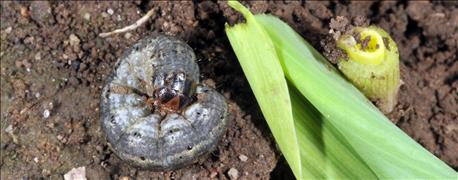May 31, 2016

It’s not a crisis situation – yet – but scouting should commence as damage is showing up in Ohio corn from black cutworns.
“We’ve seen some fields with cutting damage,” says Kelley Tilmon, a field crop entomologist with Ohio State University Extension and the Ohio Agricultural Research and Development Center.
Already, there have been reports of high numbers of black cutworm in traps across the Midwest set up by entomologists to determine the number of moths migrating up from the South, which suggests that the pests may be in some fields, she said.
However, that doesn’t always mean that they will be out in fields in higher numbers, Tilmon says.

Location and condition of fields key to arrival of black cutworms
“Adult black cutworm moths lay eggs that hatch into the cutworm caterpillars,” she says. “Developing larvae feed on emerging corn, meaning growers need to look out for corn with leaf feeding or stem cutting as the crop emerges.
“Although there are some hotspots for egg laying, these predictions are far from exact. “Because the pest can cause stand loss in corn, Tilmon says, “This is a reminder that growers need to be on the lookout.”
Female black cutworm moths tend to lay eggs in fields with heavy weed cover, and as the weeds are killed by herbicide or tillage, the larvae move on to feed on emerging corn, she adds.
Black cutworms can cause severe cutting of the plant, with the resulting stand loss in corn generally associated with below- or at-ground-level feeding injury, which occurs below the growing point, Tilmon said.
Another concern for crop damage is the fact that much of the corn in the region is being planted relatively late this spring, as cooler, wetter weather conditions have delayed many growers from getting out into their field.
“So corn will be rather small when the larvae of these pests begin their heavier feeding,” Tilmon says. “Thus, the potential for plant injury and subsequent economic losses will be much higher than normal because of the size of the corn.”
Across Ohio, as of the week ended May 22, only 51% of corn was planted, according to the U.S. Department of Agriculture’s National Agricultural Statistics Service. That compares to 84% that had been planted by the same time last year and 66% that had been planted on average during the same time period over the past five years, the agency said.
And 28% of corn has emerged as of the week ended May 22, the agency said. That compares to 62% emerged by the same time period last year and 41% emerged on average during the same time period over the past five years, the agency says.
Growers should start scouting for black cutworm as soon as the corn begins to emerge, Tilmon says.
“Cutting damage is pretty obvious to see,” she said. “It looks like the plants have been clipped off if the feeding of the plants happens above ground.
“Underground feeding results in the plants having more of a wilted appearance. So growers should be on the lookout for more than one type of damage.”
Rescue treatments can be applied if necessary, Tilmon says, noting that if the cutting damage is above ground, cut plants will likely recover if a timely rescue treatment is applied.
You May Also Like




